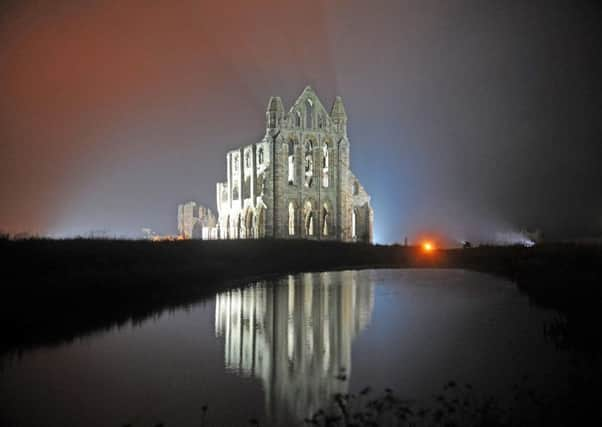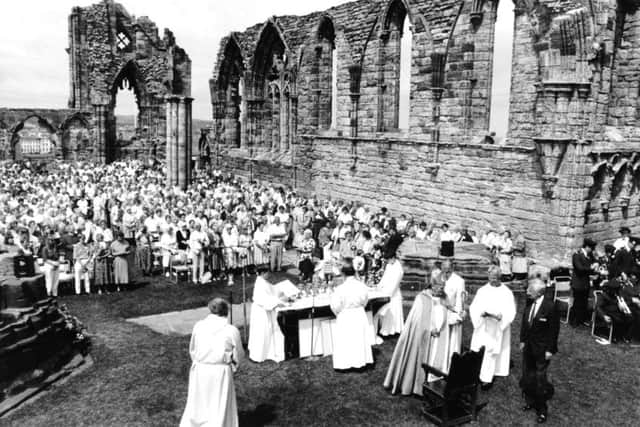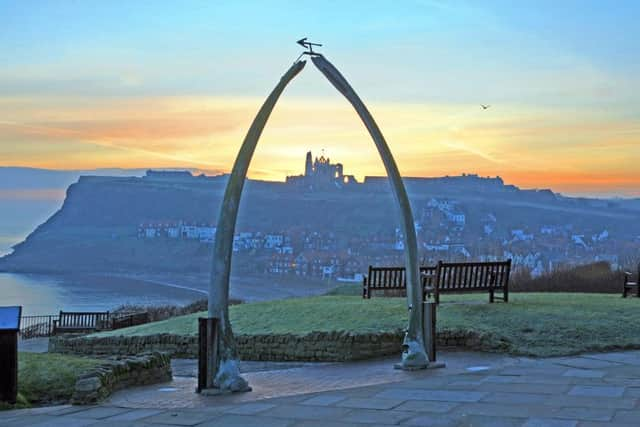Nostalgia on Tuesday: High and Mighty


The ruinous Abbey church we see today perched on the headland was built from the 13th century onwards, though there is much history to delve into before that time.
During the late Bronze Age, archaeological evidence suggests there was an early settlement comprising a round house inside a ditched enclosure near the Abbey headland. A number of objects dating from the period have been unearthed.
Advertisement
Hide AdAdvertisement
Hide AdIn the 3rd century, at the time of Roman occupation, a signal station may have existed on a now eroded cliff-side spot. This was strategically positioned at the mouth of the River Esk.


After Roman rule, Britain fragmented into a number of areas and by the 7th century, Northumbria, including much of Northumberland and Yorkshire, was the strongest of the Anglo Saxon kingdoms. The Whitby headland was occupied by a large Anglian community and this is supported by discoveries of pottery, household goods and metal objects from the period.
The name ‘Anglian’ is used to distinguish the people who settled on the eastern seaboard of Britain in the 5th and 6th centuries from the Saxons and Jutes who arrived further south.
Around 657, Hild (614 -680), an Anglian nobleman’s daughter, supported by Oswiu (d. 670), King of Northumbria, founded a monastery for both monks and nuns on the headland then known as Streaneshalch (probably meaning ‘Streane’s headland’).
Advertisement
Hide AdAdvertisement
Hide AdSeven years later, the area became one of the most important religious centres in the Anglo Saxon world, and the setting for the Synod of Whitby – a vital turning point in the Church in England’s development.


Kings and nobles came to pray and seek advice, and the headland became the main royal place of burial for Northumbria.
The Anglian monastery was abandoned due, it is suspected, from Viking raids from Denmark in the mid-9th century. By the 11th century the headland settlement was also gone, succeeded by a sizeable town, certainly founded by Danish settlers, with a Danish name Whitby, down by the harbour.
There were new beginnings in the 11th century when a monk, Reinfrid, founded a new monastic community on the Whitby headland. Within a short space of time this community separated and the two parts each developed into a well established Benedictine monastery: one at Whitby at the other at St Mary’s Abbey, York.
Advertisement
Hide AdAdvertisement
Hide AdThe first Benedictine Abbey church, conventual buildings as well as a large parish church were erected in stone in the Romanesque style at Whitby from about 1109. The Abbey church followed a classic Benedictine design, ultimately derived from the great monasteries in Normandy.


Then, starting in the 13th century, the Abbey church was rebuilt, in the Gothic style – the remains of this structure are what we see today. Abbot Roger of Scarborough (abbot from about 1223 to 1245) probably ordered the reconstruction.
Whitby’s rebuilding work began from about 1225-50 and included erecting the crossing and transepts, a central tower, and part of the nave.
With finances depleted after this burst of activity, work was not resumed until the 14th century. Completion of the nave stretched into the 15th century. The Abbey church, dedicated to St Peter and St Hild, was more than 90ft long – the size of a small cathedral.
Advertisement
Hide AdAdvertisement
Hide AdExtensive monastic buildings south of the Abbey church were also erected during this long stretch of construction.


Whitby’s last abbot, Henry Davell, surrendered the monastery to King Henry VIII’s commissioners on December 14, 1539. At the time there were 22 members of the community.
The entire site was acquired by the Cholmley family. They mostly demolished the monastic buildings but preserved the shell of the Abbey church and adapted the former abbot’s lodgings as a residence. This was extended in the 16th century and remodelled in the 17th century.
Over the next two centuries the Abbey church, which was substantially complete until the 18th century, began to collapse. The south transept fell in 1736, much of the nave in 1763, the central tower in 1830 and the south side of the presbytery in 1839. The haunting Abbey church ruins became a tourist attraction as Whitby grew in popularity as a seaside resort in the early 19th century.
Advertisement
Hide AdAdvertisement
Hide AdIn 1897 Whitby gained a major literary association with the publication of Bram Stoker’s vampire novel Dracula. After a trip to Whitby in 1890, where he stayed in the Royal Hotel, Stoker made the town the scene for a good section of the novel.
The Abbey church was further damaged in 1914 when the German High Seas Fleet fired on Whitby and struck the west front of the building.
In 1920 the Abbey church was handed over from the Strickland family (descendants of the Cholmleys) to the Ministry of Works. The first excavations on the site directed by Sir Charles Peers were undertaken in the following decade.
English Heritage took control in 1984 and further excavations have been carried out revealing further chunks of the area’s history.
A Whitby Goth Weekend was launched in 1994 and is now one of the world’s most popular ‘Goth’ events.